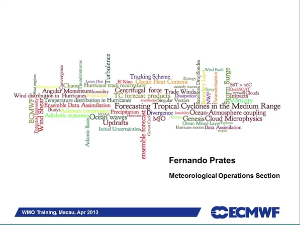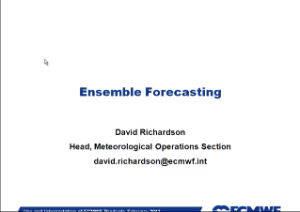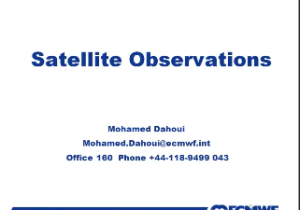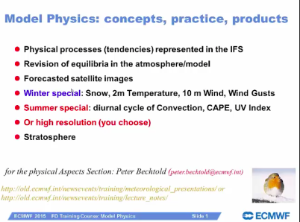- Created by Unknown User (maz), last modified by Sarah Keeley on Aug 06, 2015
You are viewing an old version of this page. View the current version.
Compare with Current View Page History
« Previous Version 68 Next »
You can download our resources from here:
Webinars and slidecasts are in mp4 format. Please click on the icon to get the mp4 ( if you cannot play it, please download the MP4 file by right clicking and choosing 'Save link as' . Play it locally with Windows media player, or quicktime or VLC (free software))
Lecture notes are in PDF format
You will need to contact your administrator.
Our Webinars (recordings)
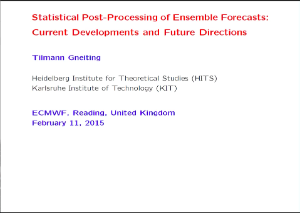
Statistical post-processing of ensemble weather forecasts: Current developments and future directions (Tilmann Gneiting) - Statistical post-processing techniques serve to improve the quality of numerical weather forecasts, as they seek to generate calibrated and sharp predictive distributions of future weather quantities and events. I will review the state of the art in post-processing, with focus on ensemble forecasts and ongoing joint work between the ECMWF and the Computational Statistics group at the Heidelberg Institute for Theoretical Studies (HITS). Current and future challenges include the treatment of extreme events, and the calibration of probabilistic forecasts of combined events and spatio-temporal weather trajectories, for which discrete copula based techniques, such as ensemble copula coupling (ECC) and the Schaake shuffle, are attractive options. . Click here to download the recording.
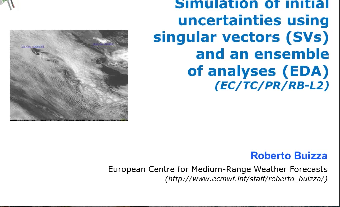
The aim of this webinar is to introduce the ECMWF ensemble of data assimilation (EDA). The rationale and methodology of the EDA will be illustrated, and its use in to simulate initial uncertainties in the ECMWF ensemble prediction system (ENS) will be presented.This webinar was delivered by Dr. Roberto Buizza and recorded in May 2014. Click here to download the recording.
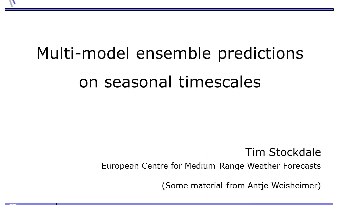
This lecture looks at calibration and multi-model ensembles from a seasonal forecasting perspective. The theoretical basis is given, followed by research results that strongly motivated a multi-model approach for these timescales. The operational EUROSIP multi-model system is described. This Webinar was delivered by Dr. Tim Stockdale and recorded in May 2014. Click here to download the recording.

This Webinar was delivered by Dr. Gianpaolo Balsamo and recorded in May 2013. It is an introduction to surface processes that are relevant for NWP models. Click here to download the recording.
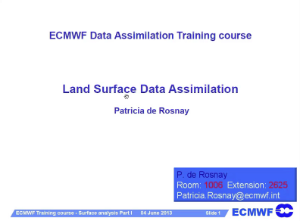
This webinar was delivered by Dr. Patricia De Rosnay and recorded in May 2013. It is the first of two webinars on Data Assimilation for surface parameters. It covers assimilation techniques used at ECMWF. Click here to download the recording.
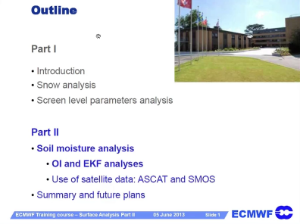
This webinar was delivered by Dr. Patricia De Rosnay and recorded in May 2013. It is the second of two webinars on Data Assimilation for surface parameters. It covers assimilation techniques used at ECMWF. Click here to download the recording.

This Webinar was delivered by Mr. Tim Hewson and recorded in February 2015. The process by which extra tropical cyclones are identified and tracked in the ECMWF IFS analyses and forecasts will be described, and this will be followed by an overview of the multi-faceted web products that relate, and how to use them. Reference will also be made to objective fronts.
Click here to download the recording (Lecture slides are available here)
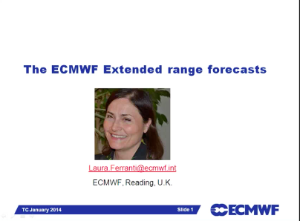
This Webinar was delivered by Dr. Laura Ferrati and recorded in February 2015. This presentation is an introduction to the ECMWF Extended range forecasts. The main sources of predictability at the sub-seasonal time scale will be introduced. The ECMWF forecasting system will be discussed as well as its products and its past performance. Click here to download the recording. (Lectures slides are available from here)

This Webinar was delivered by Dr. Laura Ferrati and recorded in February 2013. It describes the Seasonal Forecasting system at ECMWF, its products and their interpretation. Click here to download the recording.

This Webinar was delivered by Dr. Richard Forbes and recorded in February 2015. This seminar will describe how cloud and precipitation is represented in the ECMWF global model with examples of model evaluation against different types of observations and strengths and weaknesses highlighted. The cloud related forecast products are discussed with some insights into interpretation in different meteorological situations. By the end of this seminar you should be able to: 1. Describe how cloud and precipitation is represented in the ECMWF global model 2. Recognise some of the strengths and weaknesses of the forecast cloud/precipitation. 3. Interpret cloud and precipitation related forecast products.
Click here to download the recording. (Lectures slides are available from here)
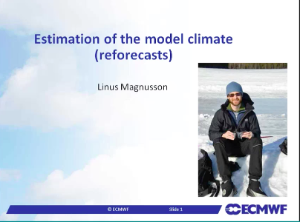
This Webinar was delivered by Dr. Linus Magnuson and recorded in February 2015. The aim the lecture is to give a motivation for why ECMWF produces a data set for the model climate, explain the configuration of it and discuss some of the strengths and weaknesses (limitations). In the lecture we will also explain the cumulative distribution function of the model climatology, as a background for the extreme forecast index (EFI).
Click here to download the recording. (Lectures slides are available from here).
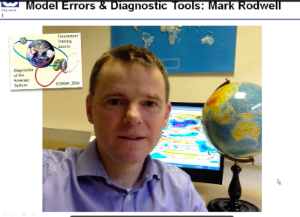
This webinar was delivered by Dr. Mark Rodwell and recorded in February 2015. Diagnostics at ECMWF is about looking for weaknesses in the forecasting system, trying to identify their causes, working with developers, and documenting the resulting changes in performance. As observation volumes increase, and models get more complex, accurate and represent smaller-scale weather features, and as the need for uncertainty information grows, diagnostic tools need to be ever more powerful and precise. Here, with the help of a few case studies, I will discuss the development of these tools, and how they are helping us identify residual deficiencies.
Click here to download the recording. (Lectures slides are available from here).
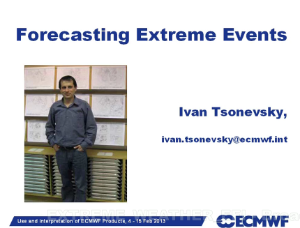
This webinar was delivered by Mr. Ivan Tsonevsky and recorded in February 2015. The Extreme Forecast Index (EFI) has been developed at ECMWF to alert forecasters to anomalous or extreme weather events by comparing the Ensemble Forecasts (ENS) with the model climate as a reference. The Shift Of Tails (SOT) was implemented in 2012 to complement the EFI by providing additional information about the extremity of a given weather event. This talk will give an overview of the use and interpretation of the EFI and SOT for forecasting extreme weather. It will provide information about some limitations of the EFI products and the future plans in the severe weather forecasting at ECMWF. A lot of practical examples will be used throughout the talk to explain and clarify different aspects of the EFI products in forecasting hazardous and anomalous weather events.
Click here to download the recording. (Lectures slides are available from here).
The aim of this webinar is to introduce the main sources of uncertainty that lead to forecast errors. The weather prediction problem will be discussed, and stated it in terms of an appropriate probability density function (PDF). The concept of ensemble prediction based on a finite number of integration will be introduced, and the reason why it is to be the only feasible method to predict the PDF beyond the range of linear growth will be illustrated.This Webinar was delivered by Dr. Roberto Buizza and recorded in May 2014. Click here to download the recording.
Our Slidecasts (slides and audio recordings)
This lecture was delivered by Dr. Franco Molteni and recorded in May 2014. Click here to download the recording

This lecture was delivered by Dr. Franco Molteni and recorded in May 2014. Click here to download the recording
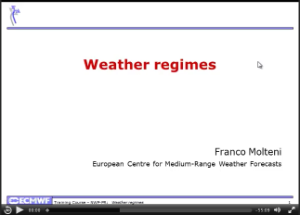
This lecture was delivered by Dr. Franco Molteni and recorded in May 2014. Click here to download the recording
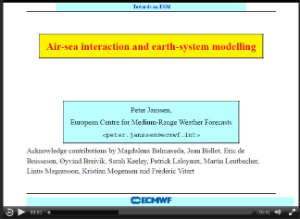
Recently, there is in increasing interest in trying to understand the properties of coupled atmosphere, ocean-wave, ocean/sea-ice models with an ultimate goal to start predicting weather, waves and ocean circulation on time scales ranging from the medium-range to seasonal timescale. Such a coupled system not only requires the development of an efficient coupled forecasting system but also the development of a data assimilation component.This lecture was delivered by Dr. Peter Jansen and recorded in May 2014. Click here to download the recording
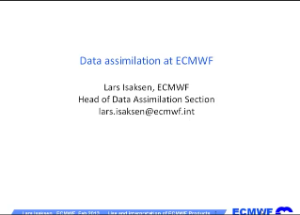
This lecture was delivered by Dr. Lars Isaksen and recorded in February 2015. It describes the data assimilation system at ECMWF, and its future evolution. Click here to download the recording.
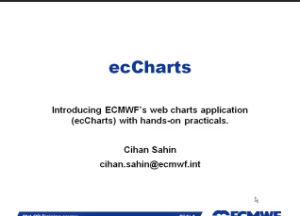
This lecture was delivered by Mr. Cihan Sahin and recorded in February 2013. It is a basic introduction to a web based application called ecCharts to visualise ECMWF data. Click here to download the recording.
Our Tutorials (videos)
ECPDS

The video explains the main architecture behind ECPDS followed by the main concepts behind it such us Destination and Host and the configurable options that they have.
Click here to see the video

The video shows how to log in to ECPDS, start and stop and check the several status of a destination.
Click here to see the video

The video explains the file filters available in ECPDS and how to see the volumes in dissemination.
Click here to see the video

The video explains the transfer table and how to requeue files, change priorites, extend lifetime ...
Click here to see the video

The video explains how to see host configuration, activate/deactivate hosts, make traceroute/ping.
Click here to see the video

The video shows the timeline funtionality, which allows to identify problems with transfers when they take longer than usual.
Click here to see the video

This video shows how to find the monthly, hindcast and seasonal files in ECPDS.
Click here to see the video
Our NWP training material
Lecture Guide and Learning Goals
This year we are providing an overview of each of the lectures and the things you should learn from each lecture. Click on a lecture title to find out more...
Downloads of the presentations are available below each lecture
| Monday | Tuesday | Wednesday | Thursday | Friday |
|---|---|---|---|---|
In this lecture we will give you a brief history of ECMWF and present the main areas of NWP research that is currently being carried out in the centre. We then look at current research challenges and present some of the latest developments that will soon become operational. By the end of the lecture you should be able to:
Erland Källén, Sarah Keeley | Assimilation Algorithms: (2) 3D-Var Mike Fisher
| Assimilation Algorithms: (3) | The aim of this lecture is to introduce the concept of the EnKF in the context of atmospheric data assimilation. Strengths and weaknesses of the algorithm will be discussed and results of the ECMWF implementation will be presented. By the end of the lecture the participants should be able to: • Describe the basic EnKF algorithm and its connections with the Kalman Filter; • Discuss some of the advantages and the limitations of EnKF algorithms with respect to more established variational algorithms; • Be aware of recent developments in hybrid variational-EnKF data assimilation Massimo Bonavita
| The Ensemble of Data Assimilations (EDA) technique is used for the estimation of the analysis and background errors of the ECMWF assimilation system. This lecture describes the EDA formulation and implementation, and how it interacts with ECMWF 4DVar analysis and ECMWF Ensemble Prediction System. By the end of the lecture the participants should be able to:
Massimo Bonavita |
Assimilation Algorithms: (1) Basic concepts Mike Fisher | Background error modeling and non-Gaussian aspects of data assimilation Elias Holm BGErr_lecture_2014.pdf | This lecture provides an overview of a typical ocean data assimilation system for initialization and re-analyses application. The lecture uses as an example the ECMWF ocean data assimilation system, which is based the NEMOVAR (3Dvar FGAT). This will be used to discuss design of the assimilation cycle, formulation of error covariances, observations assimilated and evaluation procedure, among others. By the end of the lecture students should be able to:
Magdalena Alonso-Balmaseda
| The primary purpose of this lecture is explore the implications of the fact that satellites can only measure radiation at the top of the atmosphere and do not measure the geophysical variables we require for NWP (e.g. temperature, humidity and wind). The link between the atmospheric variables and the measured radiances is the radiative transfer equation - the key elements of which are discussed. It is shown how - with careful frequency selection - satellite measurements can be made for which the relationship to geophysical variables is greatly simplified. Despite these simplifications, it is shown that the extraction of detailed profile information from downward looking radiance measurements is a formally ill posed inverse problem. Data assimilation is introduced as the solution to this inverse problem, where background information and satellite observations are combined to produce a best or optimal estimate of the atmospheric state. The main elements of the assimilation scheme (such as the chain of observation operators for radiances) and its key statistical inputs are examined. In particular it is shown that incorrect specification of observation errors (R) and background errors (B) can severely limit the successful exploitation of satellite data. By the end of this lecture you will:
Tony McNally | In this lecture, the impact of model error on variational data assimilation will be presented. This lecture will introduce weak-constraint 4D-Var as a way to account for model error in the data assimilation process. Several examples of results from simplified implementations in the IFS will be shown. By the end of the lecture the participants should be able to:
Yannick Tremolet |
The aim of this session is to present an overview of the current observing systems used in Numerical Weather Prediction. We will discuss our observational requirement, and how close the current observing system is to meeting our needs. We will also discuss areas where our requirements are evolving. We will learn about WMO's OSCAR database that describes the Global Observing System. We will learn how the large diversity of observations now available, are monitored to ensure only good observations are presented to an operational system. By the end of the session you should be able to:
Tony McNally | The aim of these sessions is to understand the role of land surface data assimilation on medium range weather forecasts. We will give an overview of the different approaches used to assimilate land surface data and to initialise model variables in NWP. We will present the current observing systems and describe the land data assimilation structure within ECMWF system. By the end of the session you should be able to:
Patricia de Rosnay surface_analysis_2015_part2.pdf | The goal of this lecture is to familiarise the student with the notion of tangent linear and adjoint models, and their use in variational data assimilation. A general overview of the current use of tangent linear and adjoint models in the ECMWF system will also be provided. Theoretical definitions and practical examples of tangent liner and adjoint models will be given. The student will be invited to work some simple tangent linear and adjoint derivations together with the instructor. A brief introduction to automatic differentiation software will also be given./ By the end of the session you should be able to:
Angela Benedetti
| Diagnostics: (2) Forecast Sensitivity Carla Cardinali | At ECMWF atmospheric composition data are assimilated into the IFS as part of the MACC-II project. On a global scale, atmospheric composition represents the full state of the global atmosphere covering phenomena such as desert dust plumes, long-range transport of atmospheric pollutants or ash plumes from volcanic eruptions, but also variations and long-term changes in the background concentrations of greenhouse gases. The aim of this lecture is to give an overview of the work that is carried out at ECMWF regarding the assimilation of atmospheric composition data, and to address why this is of interest and which special challenges are faced when assimilating atmospheric composition data. By the end of the session you should:
Antje Inness
|
The aim of these sessions is to understand the role of land surface data assimilation on medium range weather forecasts. We will give an overview of the different approaches used to assimilate land surface data and to initialise model variables in NWP. We will present the current observing systems and describe the land data assimilation structure within ECMWF system. By the end of the session you should be able to:
Patricia de Rosnay | Diagnostics (1) Self Sensitivity Carla Cardinali Observation_Influence_Lecture1.pdf | Toy Model Practice Session (1) OR Mike Fisher, Yannick Tremolet, Martin Leutbecher | The aim of this session is to understand how data assimilation can improve our knowledge of past weather over long time-scales. We will present recent advances that help capture changes over time in observing system networks, and project this variation in information content into uncertainty estimates of the reanalysis products. We will also discuss the applications of reanalysis, which generally put weather events into the climate context. By the end of the session you should be able to:
Paul Poli Poli_2015_TC_DA_Reanalysis_with_notes.pdf | Quality Control of observations |
Aspects of using observations in data assimilation Lars Isaksen LI_DA_TC_2015_Observations.pdf Followed by drinks reception | In this lecture the variational bias correction scheme (VarBC) as used at ECMWF is explained. VarBC replaced the tedious job of estimating observation bias off-line for each satellite instrument or in-situ network by an automatic self-adaptive system. This is achieved by making the bias estimation an integral part of the ECMWF variational data assimilation system, where now both the initial model state and observation bias estimates are updated simultaneously. By the end of the session you should be able to realize that:
Hans Hersbach | Toy Model Practice Session (2) OR Mike Fisher, Yannick Tremolet, Martin Leutbecher | This one-hour lecture will identify the challenges associated with the use of physical parametrizations in the context of four-dimensional variational data assimilation (4D-Var). The importance of the linearity constraint in 4D-Var and the methods to address it will be detailed. The set of linearized physical parametrizations used at ECMWF will be briefly presented. Examples of the use of physical parametrizations in variational data assimilation and its impact on forecast quality will be given. By the end of the lecture, the students should be able:
Philippe Lopez | Question/answer session Course evaluation 16:-16:30 Sarah Keeley |
Week 1:
| Monday | Tuesday | Wednesday | Thursday | Friday |
|---|---|---|---|---|
Introduction to the course | The aim of the this lecture is to discuss basic concepts behind initial perturbation techniques. After the lecture you should be able to:
Linus Magnusson | Franco Molteni | Abstract: The lectures introduce methods of ensemble verification. They cover the verification of discrete forecasts (e.g. dry/wet) and continuous scalar forecasts (e.g. temperature). Various scores such as the Brier score and the continuous ranked probability score are introduced. After the lectures you should be able to
Martin Leutbecher | Increasing observation volumes and model complexity, decreasing errors, and a growing desire for uncertainty information, all necessitate developments in our diagnostic tools. The aim of these lectures is to discuss some of these tools, the dynamical insight behind them, and the residual deficiencies that they are highlighting. By the end of the lectures you should be aware of:
Mark Rodwell see previous lecture for notes |
Tim Palmer - given by Sarah Keeley | In this session the generation of the perturbed initial condition of the ECMWF ensemble will be presented. We will discuss the ratio behind using singular vectors in the ensemble and how they are calculated. Then it will be explained how the singular vectors are combined with perturbations from the ensemble of data assimilations to construct the perturbations for the ensemble. By the end of the session you should be able to:
Simon Lang
| Abstract: The lectures introduce methods of ensemble verification. They cover the verification of discrete forecasts (e.g. dry/wet) and continuous scalar forecasts (e.g. temperature). Various scores such as the Brier score and the continuous ranked probability score are introduced. After the lectures you should be able to
Martin Leutbecher |
Franco Molteni | The aim of this session is to provide a general overview of monthly forecasting at ECMWF. We will review the main sources of predictability for the sub-seasonal time scale, including the Madden Julian Oscillation, sudden stratospheric warmings (SSWs), land initial conditions and their simulation by the coupled IFS-NEMO system. The skill of the ECMWF operational monthly forecasts will also be discussed. By the end of the session you should be able to:
Frederic Vitart |
The aim of this session is to introduce the main sources of uncertainty that lead to forecast errors. The weather prediction problem will be discussed, and stated it in terms of an appropriate probability density function (PDF). The concept of ensemble prediction based on a finite number of integration will be introduced, and the reason why it is to be the only feasible method to predict the PDF beyond the range of linear growth will be illustrated. By the end of the session you should be able to:
Roberto Buizza | In this lecture we will give you a brief history of ECMWF and present the main areas of NWP research that is currently being carried out in the centre. We then look at current research challenges and present some of the latest developments that will soon become operational. By the end of the lecture you should be able to:
Sarah Keeley & Erland Källén | The aim of this session is to introduce the ECMWF ensemble of data assimilation (EDA). The rationale and methodology of the EDA will be illustrated, and its use in to simulate initial uncertainties in the ECMWF ensemble prediction system (ENS) will be presented. By the end of the session you should be able to:
Roberto Buizza | Increasing observation volumes and model complexity, decreasing errors, and a growing desire for uncertainty information, all necessitate developments in our diagnostic tools. The aim of these lectures is to discuss some of these tools, the dynamical insight behind them, and the residual deficiencies that they are highlighting. By the end of the lectures you should be aware of:
Mark Rodwell | This lecture covers the essentials of building a numerical seasonal forecast system, as exemplified by the present prediction system at ECMWF.
By the end of this lecture, you should be able to:
Tim Stockdale
|
Sarah Keeley
| Sources_predictability2.pdfAfter this lecture, students will be able to:
Sarah-Jane Lock | This lecture provides a broad overview of the role of the ocean on the predictability and prediction of weather and climate. It introduces some basic phenomena needed to to understand the time scales and nature of the ocean-atmosphere coupling. Magdalena Balmaseda | Practice Session: You get the opportunity to experiment yourself with an ensemble prediction system for a chaotic low-dimensional dynamical system introduced by Edward Lorenz in 1995. Experiments permit to study the role of the initial condition perturbations and the representation of model uncertainties. Various metrics introduced in the ensemble verification lectures will be applied in this session.
After the practice session, you will be able to use the toy model as an educational tool. Martin Leutbecher
| 2.45pm Discussion Session in the Weather Room The latest medium, monthly and seasonal forecasts will be discussed in terms of out look and performance. This is a combined event with the weekly weather discussion that ECMWF staff attend. |
This lecture will give an overview of the general circulation of the atmosphere as a refresher. Starting from a radiative energy balance perspective the dominating atmospheric circulation systems will be described. The coupling between Hadley cell dynamics and surface friction will be covered as well as midlatitude jets and baroclinic instability. Orographic steering of large scale Rossby waves and flow regime behaviour will also be discussed.
By the end of the lecture you should be able to:
Erland Källén | The aim of this session is to illustrate the key characteristic of the nine operational global, medium-range ensemble systems. These are the ensembles available also within the TIGGE (Thorpex Interactive Grand Global Ensemble) project data-base. Similarity and differences in the approaches followed to simulate the sources of forecast uncertainties will be discussed, and their relevance for forecast performance will be illustrated. By the end of the session you should be able to:
Roberto Buizza |
Recently, there is in increasing interest in trying to understand the properties of coupled atmosphere, ocean-wave, ocean/sea-ice models with an ultimate goal to start predicting weather, waves and ocean circulation on time scales ranging from the medium-range to seasonal timescale. Such a coupled system not only requires the development of an efficient coupled forecasting system but also the development of a data assimilation component. During the lecture I will briefly describe the components of the coupled system. Peter Janssen
| Practice Session: You get the opportunity to experiment yourself with an ensemble prediction system for a chaotic low-dimensional dynamical system introduced by Edward Lorenz in 1995. Experiments permit to study the role of the initial condition perturbations and the representation of model uncertainties. Various metrics introduced in the ensemble verification lectures will be applied in this session.
After the practice session, you will be able to use the toy model as an educational tool.
Martin Leutbecher | Lecture and Practice Session: Abstract: The lecture is a short introduction to operational hydrological ensemble prediction systems, with focus on flooding. The European Flood Awareness System (EFAS) is described. The lecture also contains a short interactive exercise in decision making under uncertainty using prbabilistic forecasts as an example. By the end of the session you should be able to:
Fredrik Wetterhall Wetterhall_Flood-forecasting.pdf |
Week 2:
| Monday | Tuesday | Wednesday | Thursday | Friday |
|---|---|---|---|---|
The aim of this session is to understand the ECMWF clustering products. By the end of the session you should be able to:
Laura Ferranti | This lecture gives an overview of ensemble and post-processing and calibration techniques. The presentation is made from the medium-range forecast perspective. The (relative) benefits of calibration and multi-model combination for medium-range forecasting are also discussed.
By the end of this lecture, you should be able to:
Tim Stockdale | Practice Session: Ensemble predictions and Risk Evaluation |
| |
Practice Session: Ensemble Verification Simon Lang/Linus Magnusson | By the end of the session you should be able to:
Francesca Di Guiseppe | Question and Answer session: Tim Stockdale, Franco Molteni, Martin Leutbecher, Roberto Buizza
| ||
Practice Session: Ensemble Verification Simon Lang/Linus Magnusson |
Jean Bidlot | Course wrap up and certificates Sarah Keeley | ||
The aim of this session is to understand the role of sea ice for medium to extended range forecasts. We will discuss the mechanisms that give rise to sea ice predictability on seasonal to interannual timescales. We will present an overview of the current observing systems and the representation of sea ice within ECMWF system.
By the end of the session you should be able to:
Sarah Keeley | The aim of this session is to provide a general overview of the application of probabilistic medium-to-long-range forecasts in meteorological drought applications. We will review the main drought concepts and how probabilistic forecast can be adapted to typical drought indicators. By the end of the session you should be able to:
Emanuel Dutra | |||
Magdalena Balmaseda | This lecture looks at calibration and multi-model ensembles from a seasonal forecasting perspective. The theoretical basis is given, followed by research results that strongly motivated a multi-model approach for these timescales. The operational EUROSIP multi-model system is described.
By the end of this lecture, you should be able to:
Tim Stockdale |
- No labels


